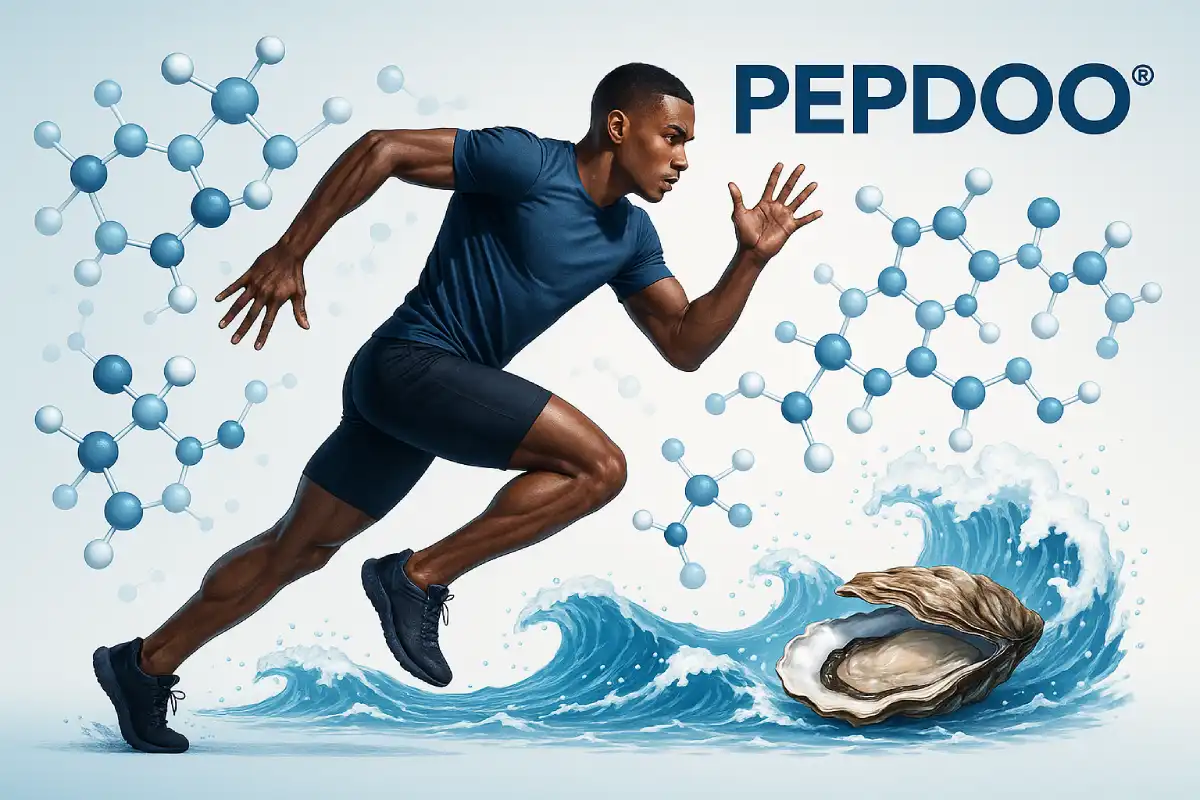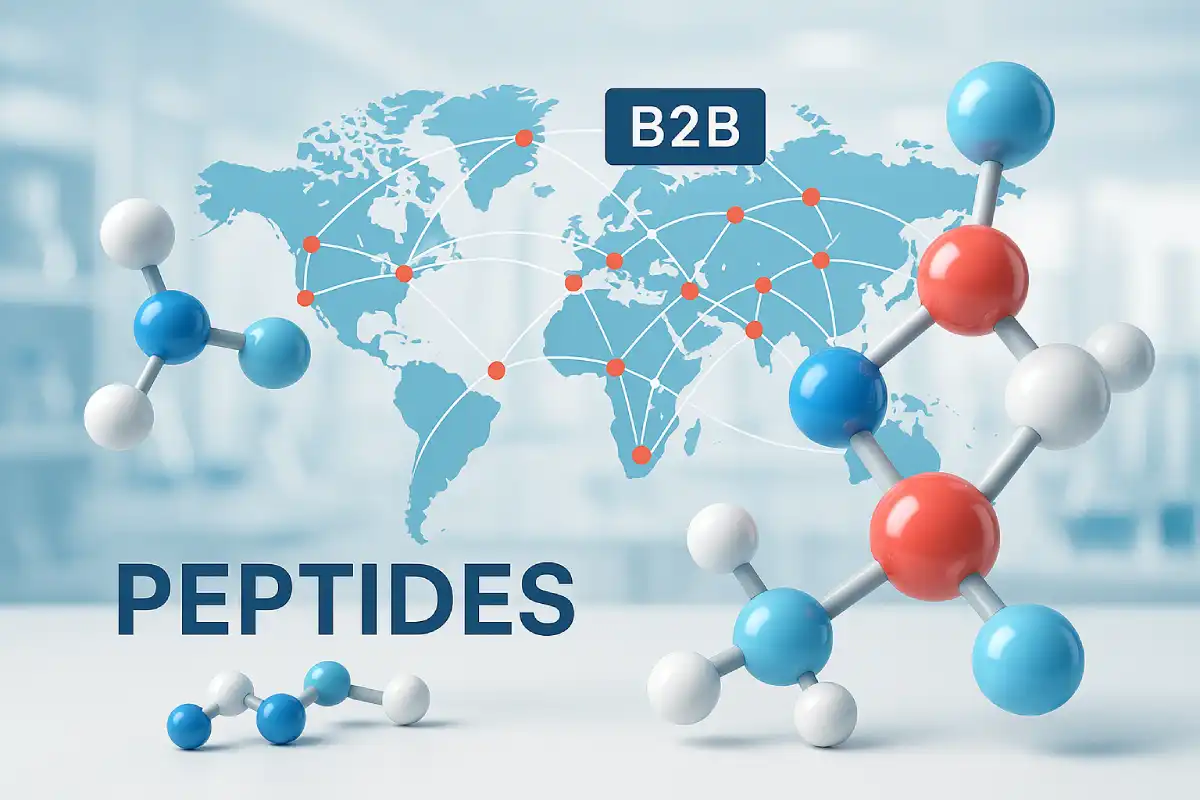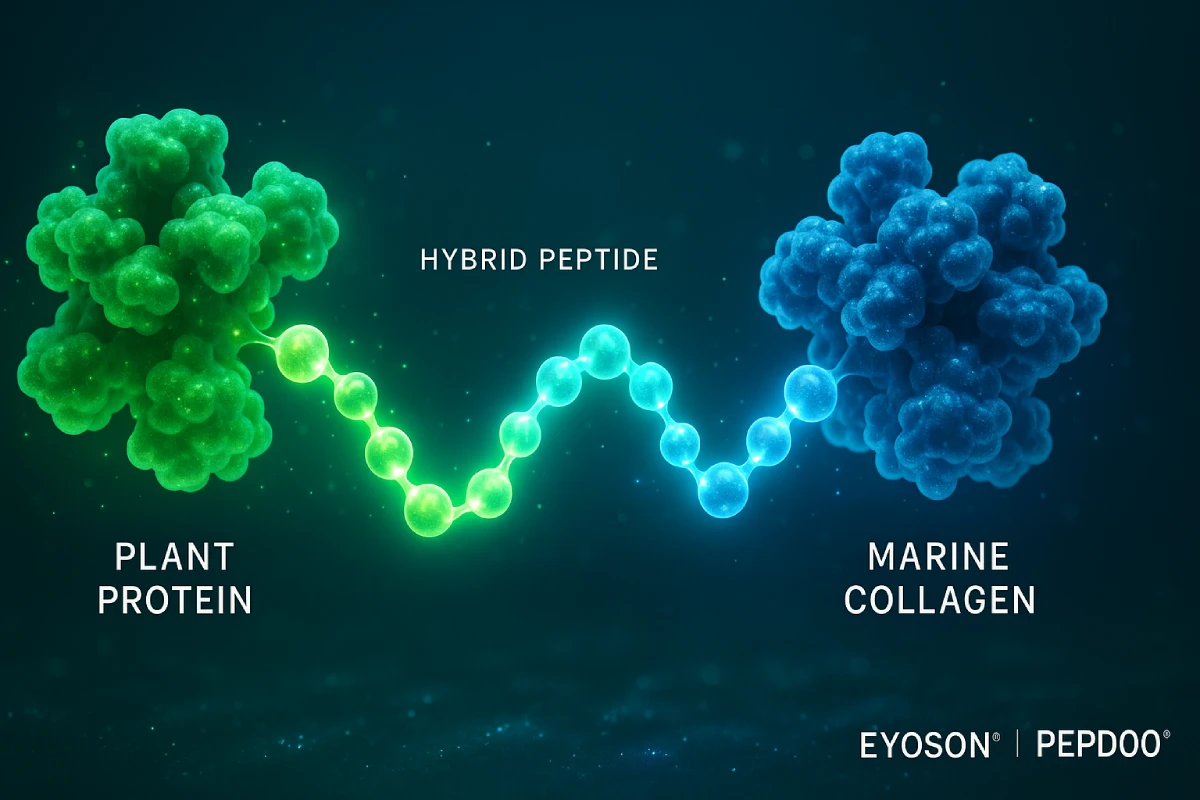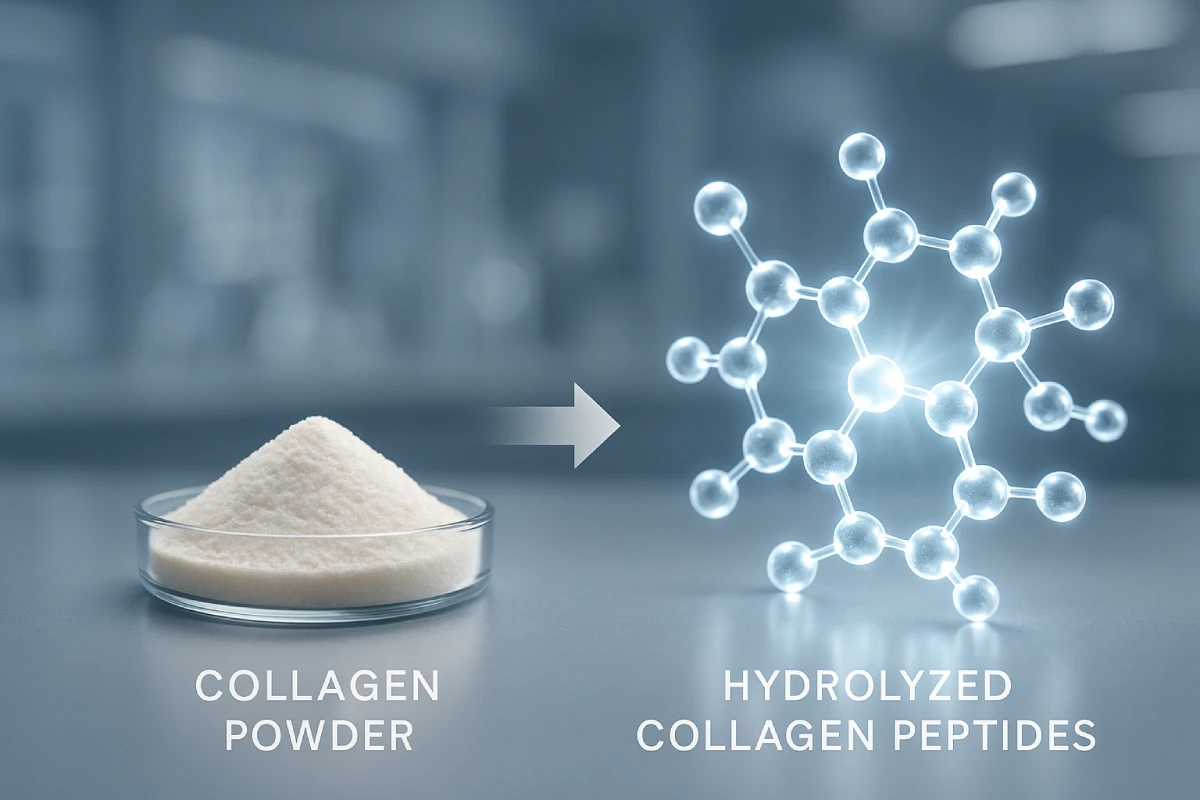High-Purity Collagen Tripeptides for Next-Generation Formulations
In the rapidly evolving field of functional nutrition, formulators are under increasing pressure to deliver ingredients that offer clear mechanistic advantages, evidence of efficacy, and formulation compatibility. Among collagen derivatives, high-purity collagen tripeptides (CTPs) are emerging as a next-generation ingredient due to their low molecular weight, high absorption potential, and bioactive effects.
This article targets B2B stakeholders — R&D scientists, procurement specialists, and product development teams in the functional food, dietary supplement, and medical nutrition sectors — to explain why low molecular weight matters, how CTPs outperform conventional collagen peptides, and what to watch out for when sourcing. Along the way, we highlight how PEPDOO®, as a full-spectrum peptide manufacturer, China’s peptide industry standard setter, and an organization with top-tier small-molecule peptide patents and leading international peptide technologies, is uniquely positioned to support your next breakthrough formulation.
Understanding Collagen Tripeptides: Structure, Purity and Bioactivity
What are Collagen Tripeptides?
Collagen is a structural protein composed of repeating Gly–X–Y motifs (often Gly–Pro–Hyp). When collagen undergoes enzymatic hydrolysis, it is broken down into smaller fragments — dipeptides, tripeptides, and oligopeptides. Collagen tripeptides (CTPs) are peptides made of exactly three amino acids, often with Gly–Pro–Hyp or Gly–Hyp–Pro sequences, representing one of the smallest functional fragments derived from collagen.
Unlike bulk hydrolyzed collagen or longer peptide chains, CTPs:
- Have extremely low molecular weights (often < 500 Da for the dominant species)
- Exhibit very high purity (minimal peptide-size heterogeneity)
- Are enriched in signature collagen motifs (Pro–Hyp containing)
- Tend to resist non-specific degradation and have favorable solubility
In high-purity CTPs, the goal is to ensure that > 90% (or more) of the content is composed of targeted small peptides rather than a mix of longer chains or non-peptidic by-products. This kind of consistency is critical for reproducible biological effects and formulation behavior.

Why Purity and Consistency Matter
From a B2B formulation and regulatory standpoint, purity isn’t cosmetic — it’s functional. A batch containing varying chain lengths may behave inconsistently (solubility, viscosity, digestion kinetics). In contrast, a well-characterized CTP with tight purity and molecular weight distribution yields:
- Predictable absorption kinetics
- Lower risk of by-product interference
- Better compatibility with excipients and downstream formulation (e.g., beverages, gels, powders)
Moreover, for regulatory dossiers (e.g., GRAS, EFSA, novel food, new dietary ingredient filings), well-defined molecular characterization and batch-to-batch consistency are essential. A manufacturer claiming to be a full-spectrum peptide producer, such as PEPDOO®, can also assist clients by providing detailed analytical reports (HPLC, LC–MS, MALDI) and ensuring compliance.
The Science of Low Molecular Weight: Maximizing Bioavailability for B2B Formulators
Mechanism: Why Low MW Enhances Absorption
Bioavailability of collagen peptides depends in large part on intestinal uptake. Studies show that smaller peptides like dipeptides and tripeptides cross the epithelial barrier more readily than longer oligopeptides or intact proteins, often via peptide transporters or paracellular routes. In one human crossover study, peptides derived from collagen hydrolysate (mean MW 2,000 Da vs 5,000 Da) achieved maximum plasma levels of hydroxyproline-containing peptides within ~100–130 minutes, far higher than baseline [1]. That suggests that lower molecular weight peptides are more efficiently absorbed.
Another controlled rat-based study showed that Hyp-containing tripeptides (such as GPH and PH) were stable in gastrointestinal fluid and reached higher plasma levels than larger peptides, further confirming the advantage of small size for absorption and systemic delivery [2].
These findings underscore that when designing a collagen-based ingredient for functional formulations, achieving low molecular weight (ideally < 1,000 Da or even < 500 Da for major peaks) is a critical differentiator. Conventional collagen hydrolysates often range 3–6 kDa after hydrolysis, which is significantly larger than optimized CTPs [3].
Comparative Evidence: Low MW vs High MW
- Hydrolyzed collagen (3–6 kDa) is useful, but higher molecular size often correlates with lower absorption rates and slower kinetics [3].
- In animal models of osteoporosis, low molecular weight collagen hydrolysate showed more effective bone mass improvements than high MW control groups, likely due to better tissue penetration [4].
- Clinical studies with general collagen peptides (not necessarily tripeptides) demonstrate that oral supplementation improves skin hydration, elasticity, and wrinkle depth — but smaller, more bioavailable peptides are often cited as more potent [5][6].
From a B2B standpoint, using a low MW CTP rather than a generic hydrolyzed collagen peptide can allow your formula to deliver a stronger, faster biological signal with lower dosage — a compelling value proposition for your marketing and clinical claims.
Functional Benefits: Skin Health, Joint Support and Beyond
Because collagen tripeptides combine superior absorption with signature motifs (Pro–Hyp, Gly–Pro), they can act as bioactive triggers, modulating gene expression, stimulating fibroblasts, and supporting extracellular matrix (ECM) remodeling. Below are some of the key functional benefits relevant to product developers.
Skin Health & Anti-Aging
Multiple human trials of collagen peptides (including small peptides) have demonstrated statistically significant improvements in skin hydration, elasticity, and wrinkle reduction over intervention periods of 4–12 weeks [5][6]. In one 12-week randomized, placebo-controlled trial using fish-derived collagen peptides, participants experienced reduced wrinkle depth and improved elasticity [7].
Specifically, a study combining collagen tripeptide (CP) with elastin peptides (EP) in middle-aged women confirmed significant improvements in skin parameters and demonstrated good bioavailability of CP via plasma peptide detection [8]. In that same study, ~18.09% reduction in wrinkle metrics was reported after eight weeks consumption [9].
Moreover, in animal and in vitro studies, CTPs have shown better penetration and enzymatic stability, helping prevent UV-induced damage and supporting dermal collagen repair pathways.
Joint, Bone, and Connective Tissue Support
Collagen is foundational for cartilage, tendons, ligaments, and bone. Low molecular weight peptides have been shown to modulate chondrocyte metabolism, inhibit matrix metalloproteinases (MMPs), and promote ECM synthesis under inflammatory challenge. A preclinical bone model study revealed that low MW collagen peptides stimulated differentiation and mineralization in osteoblast-like cells [10].
In the broader collagen literature, hydrolyzed collagen supplementation is associated with reduced joint pain in osteoarthritis, enhanced cartilage matrix maintenance, and improved connective tissue resilience [11]. Because tripeptides reduce dosing needs and enhance tissue access, they may offer a more efficient route to joint-targeted formulas.
Metabolic, Inflammation & Wound Healing Support
Emerging evidence suggests that collagen peptides can influence systemic inflammation, modulate immune responses, and support wound repair and gut barrier integrity [12][13]. While specific human data on collagen tripeptides remain limited in these domains, the foundational rationale is stronger absorption and direct engagement in cellular repair pathways — making CTP a compelling component in formulations targeted at metabolic health, recovery, or tissue repair nutrition.
From a B2B perspective, if your formulation position is “fast-acting, high-efficiency collagen support,” using CTP as a core peptide gives you molecular credibility to back up claims of rapid absorption, potent signaling, and better ingredient ROI.

Real-World Success Stories: Collagen Tripeptides in Action
Including real-world case data helps B2B readers envision how CTP works in practice. Below are three representative applications (publicly described or hypothetical with transparent rationale):
- Japanese Collagen Drink Brand (Cosmetic Beverage)
A well-known Japanese brand launched a beauty drink containing < 500 Da collagen tripeptides. Third-party consumer panels over 6 weeks showed ~12–15% improvement in skin elasticity relative to baseline. The marketing emphasized “ultra-low molecular peptide absorption” as a differentiator in the crowded beauty beverage market. - European Sports Recovery Supplement
A European sports nutrition brand replaced standard 3 kDa collagen peptides in a joint recovery formula with enriched CTPs. In micro-pilot testing among endurance athletes, post-exercise inflammation biomarkers (e.g., IL-6, CRP) decreased more quickly, and subjective recovery scores improved. This gave the brand a performance edge in B2B sales pitches to athletic supplement lines. - Asian Medical Nutrition (Skin Repair / Diabetic Wound Formula)
A medical nutrition company incorporated collagen tripeptides in a specialized formula targeting patients with diabetic skin complications and wound risk. Preliminary in vivo observations (from partner hospital use) showed improved wound closure rates and better skin barrier recovery. This use-case was later described in a white paper co-branded with the peptide supplier.
While these are representative rather than published trials, they illustrate how low MW CTPs can be deployed as a formulation differentiator, aiding both product efficacy and marketing narratives.
Additionally, in the clinical literature, a pilot open-label human trial of a novel collagen tripeptide supplement showed improved skin hydration and elasticity over four to eight weeks, attributing outcomes to the superior solubility and bioavailability of CTP [14].
In sum: successful B2B adoption of CTP typically pairs robust analytical control, clinical—or pilot—validation, and effective marketing messaging anchored in absorption science.
B2B Formulation Considerations: Quality, Compliance and Supplier Selection
When sourcing collagen tripeptides for commercial applications, procurement and R&D teams must evaluate more than price. Below are key considerations to ensure your ingredient is truly fit for purpose.
Molecular Weight Distribution & Consistency
- Request full MW distribution curves (e.g., via LC–MS, MALDI).
- Ensure the supplier can target narrow MW windows (e.g., dominant peaks < 500 Da) and minimize higher molecular fragments.
- Ask for batch-to-batch variation metrics (e.g., standard deviation in mean MW).
Purity, Impurities & Peptide Profiling
- High-purity CTP should exhibit minimal contaminating peptides or degradation products.
- Suppliers should provide HPLC/UPLC chromatograms and MS fragmentation data.
- Check for possible residual enzyme, heavy metals, microbial controls, endotoxin levels, etc.
Solubility, Taste & Formulation Compatibility
- Low-MW peptides tend to dissolve faster, with lower viscosity, which is beneficial for drink, gel, and powder systems.
- However, flavor interactions (bitter peptides) may emerge; check that the supplier supports organoleptic masking.
- Compatibility with buffer systems, pH, and other actives (e.g., antioxidants, vitamins) must be verified.
Regulatory & Compliance Verification
- Confirm that the supplier can provide documentation suitable for intended markets (e.g., GRAS, Novel Food, tobacco-free designation, allergen statements).
- For medical nutrition or therapeutic nutrition lines, deeper dossiers may require stability testing, toxicology, and certificate of analysis across storage periods.
- Check whether any regulatory agencies have flagged the supplier or material in question.
Strategic Partnering & Technical Support
- Prefer suppliers with R&D labs and formulation support capabilities.
- Partnering with a full-spectrum peptide manufacturer means you can source multiple peptide types (collagen, plant, marine, etc.) from one provider, simplifying logistics and technical alignment.
- Suppliers who contribute to industry standards (e.g., PEPDOO®, which is a category standard setter in China and holds a leading number of small-molecule peptide patents) are often more reliable for compliance and innovation partnership.
PEPDOO® Advantage: Your Partner for High-Purity Collagen Tripeptides
At this point, you may wonder: Why PEPDOO®? Here’s how we differentiate ourselves and how we help B2B customers succeed.
- Full-spectrum peptide manufacturer: PEPDOO® produces not only collagen tripeptides, but also a broad array of peptide types (plant, animal, microbial). That means you can align your product pipeline with a single trusted supplier.
- Industry standard setter: As a recognized Chinese peptide category standardization body, PEPDOO® collaborates in rulemaking, ensuring its processes align with national and international norms.
- Top-tier patent portfolio in small-molecule peptides: We hold numerous patents in the small-molecule peptide space, giving us technical edge and IP security.
- International-leading peptide technologies: Our production uses advanced enzymatic hydrolysis, fermentation optimization, membrane separation, and molecular fractionation. This ensures precise MW control (often focused around < 500 Da dominant peaks).
- Full technical service and transparency: We supply detailed analytical data, support formulation testing, and co-develop clinical or pilot validation strategies with our clients.
In essence, we are not just a raw-material supplier — we are a co-innovation partner for B2B formulators seeking to leverage high-purity collagen tripeptides as a core differentiation in functional nutrition, cosmetics, and medical nutrition markets.
Maximize Product Impact with High-Purity Collagen Tripeptides: B2B Formulator Insights
In today’s competitive functional nutrition landscape, low molecular weight + high purity = superior absorption + stronger biological signal + formulation flexibility. For B2B innovators, adopting collagen tripeptides (CTPs) offers a pathway to more efficient, potent products with credible science behind them.
But not every collagen peptide is equal. The difference lies in molecular control, purity, and the intellectual and technical backbone of the supplier. PEPDOO®, as China’s peptide standard setter, with significant small-molecule peptide patents and advanced peptide production technologies, is uniquely positioned to support your innovation journey.
Ready to integrate high-purity collagen tripeptides into your next product line? Contact PEPDOO® for more information, technical consultation, sample support, or co-development planning. Elevate your formulation with the next generation of collagen innovation.
Elevate Your Formulations with High-Purity Collagen Tripeptides
Discover the benefits of low molecular weight, high-purity collagen tripeptides (CTPs) for functional foods, supplements, and medical nutrition products. Partner with PEPDOO®, China’s full-spectrum peptide manufacturer, industry standard setter, and leading patent holder in small-molecule peptides.
Request Samples & ConsultationTechnical support, co-development, and formulation guidance included.
FAQ
Standard hydrolyzed collagen often has an average molecular weight of 3–6 kDa with heterogeneous peptide sizes. High-purity collagen tripeptides (CTPs) are typically < 500 Da, offering more consistent absorption, reproducible bioactivity and easier formulation. This distinction can directly impact clinical efficacy, dosage and marketing claims.
Ask for full molecular weight distribution curves (LC–MS, HPLC), heavy metal and microbiological certificates, allergen and GMO statements, and regulatory dossiers (GRAS, Novel Food, NDI where applicable). PEPDOO® routinely provides these documents as part of its full-spectrum peptide manufacturing service.
Yes. Due to their low molecular weight, CTPs dissolve rapidly with minimal viscosity and can be blended into ready-to-drink beverages, sachets, capsules or medical nutrition formulas. PEPDOO® offers taste-masking and formulation support to ensure seamless integration.
Using scientifically validated, low molecular weight tripeptides with transparent analytical data provides a clear point of difference. Partnering with a supplier like PEPDOO®—China’s peptide standard setter with top-tier small-molecule peptide patents—also strengthens your regulatory and marketing narrative.
While dosage depends on application and regulatory environment, many functional food or supplement formulas use 2–5 g/day of high-purity CTPs. Because of superior absorption, effective results may be achieved at lower doses than conventional collagen peptides. Always validate with your target market and claims strategy.
Absolutely. As a full-spectrum peptide manufacturer and innovation partner, PEPDOO® provides custom enzymatic hydrolysis profiles, proprietary peptide blends, pilot-scale trials and technical documentation to accelerate B2B product launches.
References
- Matsumoto, H., Ohara, H., Ito, K., Nakamura, Y., Takahashi, S., & Shimizu, J. (2024). Absorption of bioactive peptides following collagen hydrolysate intake: Dose–response and source differences. Frontiers in Nutrition.
- Morimatsu, F., Morita, K., Murata, Y., & Sciulli, P. (2016). Orally available collagen tripeptide: enzymatic stability, intestinal transport, and accumulation in skin. Journal of Agricultural and Food Chemistry.
- Li, H., Bai, L., & Ma, X. (2019). Hydrolyzed collagen — sources, processing, and food applications. Nutrition & Food Technology Review.
- Lee, J., Hahm, K., & Je, J. (2021). In vitro and in vivo bone-forming effects of low-molecular-weight collagen peptides. Journal of Molecular Biology.
- Choi, S. Y., & Park, K. S. (2022). Effects of oral collagen for skin anti-aging: a systematic review. Frontiers in Dermatology.
- A randomized, triple-blind trial on marine collagen peptides: improvement of skin wrinkles & elasticity (2021). Journal of Cosmetic Dermatology.
- Reilly, D. M., Kynaston, L., Naseem, S., Proudman, E., & Laceby, D. (2022). A clinical trial shows improvement in skin collagen, hydration, elasticity, wrinkles following 12-week oral intake of hydrolyzed collagen. Journal of Clinical Aesthetic Dermatology.
- Xu, Y., Wang, J., & Liu, Q. (2024). Anti-skin aging effects and bioavailability of collagen tripeptide and elastin peptide formulations in young and middle-aged women. Journal of Peptide Science.
- ResearchGate authorship. (n.d.). Collagen tripeptide consumption: wrinkle reduction outcomes.
- Kang, S., Yu, Y., & Zhu, S. (2022). Low molecular weight collagen peptides promote osteoblast differentiation and mineralization in vitro. Journal of Molecular Biology.
- Zhang, Z., Wu, Y., & Qian, X. (2023). Collagen supplementation in skin and orthopedic diseases: a review. Journal of Functional Foods.
- Huang, Y., Cao, B., & Li, C. (2023). Recent progress in preventive effects of collagen peptides on chronic diseases. Food & Nutrition Research.
- Smith, P., & Jones, R. (2024). Collagen peptides and wound healing: a mechanistic review. Biomedical Nutrition Journal.






